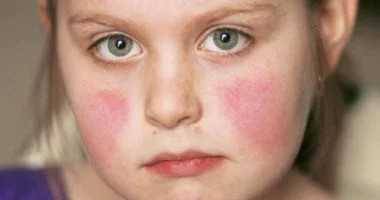In the season of contagious viruses, especially within schools as a conducive environment, one virus has garnered more attention than others due to its association with the striking redness on children’s faces, particularly among elementary school students, accompanied by a red rash, as reported by "An-Nahar." Following its appearance in three private schools in Zahle and causing concern among parents in one school due to the rash symptom, some schools decided to close their doors for a few days and extend the Teacher's Day holiday beyond the weekend to contain and reduce its spread among students.
"An-Nahar" spoke with two pediatricians in Zahle, Rabi Zaiter and Faisal Awaich, who examined cases among students and assured that there is no cause for alarm, explaining that this virus has always existed, though it has manifested more prominently this year. The rash is commonly known as Fifth Disease, according to pediatrician and gastrointestinal specialist Rabi Zaiter. This rash is caused by Parvovirus B19, which only infects humans and is not contracted from animals like dogs and cats, as clarified by pediatrician Faisal Awaich. This clarification is crucial to prevent confusion since parvoviruses typically infect animals, unlike the mentioned virus restricted to humans only.
Zaiter explains that the symptoms are those of a fever, which may be accompanied by headaches or body aches, a runny nose, and cough. It is characterized by the red rash on the face resembling a slap mark—hence its name "slapped cheek syndrome"—and he adds that the rash can spread to the rest of the body, appearing and disappearing until recovery. Awaich confirms this, noting that the syndrome appears in the age group of 5 to 15 years and is diagnosed through its symptoms, especially the rash itself, being treated like any other fever. He explains in response to a question that no laboratory test is conducted for it, as such tests are available only in some key centers in Lebanon.
On another note, Fifth Disease, named as the fifth type on the list of contagious rashes in children, revealed some private schools in the Zahle area hesitating to implement the decision to monitor school absenteeism, a practice stemming from cooperation between the Ministries of Education and Health since the H1N1 virus pandemic. This mandate requires both private and public schools to fill out a weekly form regarding absentee statistics and send it to the public health department in the district to help measure and monitor weekly absentee rates for warning signs and outbreaks, providing epidemiological data for decision-makers to guide response actions. As reported, absenteeism does not exceed 20 percent in private schools compared to 70 percent in public schools.
In the case of the virus in question, health authorities in Bekaa have not been informed by schools about its spread. Consequently, these authorities are working on collecting attendance lists from the affected schools and seeking scientific data represented by a laboratory test to diagnose the condition, should it be necessary.




